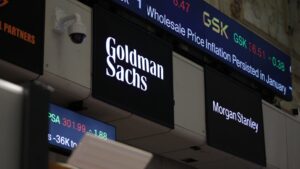Goldman Sachs Enters the Buffer ETF Arena: What It Means for Investors
As volatility looms over the stock market, investors are increasingly turning to innovative investment vehicles designed to offer protection and upside potential. Enter Goldman Sachs Asset Management, which has recently launched the Goldman Sachs U.S. Large Cap Buffer 3 ETF (GBXC), marking its foray into the growing landscape of buffer exchange-traded funds (ETFs). This offering provides a compelling opportunity for those looking to hedge against market downturns without completely sacrificing growth potential.
Understanding Buffer ETFs
Buffer ETFs, categorized as defined outcome products, are gaining traction for their unique structure that offers investors both downside protection and capped upside potential. These funds utilize derivatives, particularly equity-linked notes, to create a protective barrier around investments, attracting billion-dollar inflows from cautious investors worldwide.
In the case of the new Goldman Sachs fund, it establishes a safety net that protects against losses between 5% and 15% in the SPDR Portfolio S&P 500 ETF (SPLG). As compensation for this protection, investors face an upside cap ranging from 5% to 7%. Brendan McCarthy, global head of ETF distribution at Goldman Sachs, emphasizes that this specific range is seen as a “sweet spot” for investors who are prepared for minor fluctuations but want to avoid more significant losses.
Key Features of Goldman’s Buffer ETFs
What distinguishes Goldman Sachs’ buffer ETFs from their competitors is their reset frequency. While most buffer funds reset annually, Goldman’s funds reset quarterly, offering investors fresh versions every three months, allowing for timely adjustments to market conditions. Additionally, these funds incorporate an extra layer of safety: if the market experiences a downturn of around 25%, the total losses for investors are limited to approximately 15%.
Navigating Market Fluctuations
One crucial consideration for potential investors is how these funds are structured and how their performance dynamics play out over time. Buffer funds are designed for investors to enter near the reset date and hold through the entire period. Although prices could dip below the designated protection levels during the investment period due to changes in options pricing, patience is key. As Stuart Chaussee, a registered investment advisor from Beverly Hills, notes, holding through to the next reset period ensures that investors receive the promised parameters.
The performance of the buffer funds can be particularly interesting when held over multiple resets. If a downturn is followed by a market recovery, the gains from the rebound will be calculated based on a higher value, thus aiding in faster recovery. However, it’s worth acknowledging that during a prolonged bullish market—where stock prices exceed the upside cap—the performance of buffer funds may lag behind traditional equity investments.
Fees and Competition
Goldman Sachs has positioned its new funds with a relatively low 0.50% fee, appealing to cost-conscious investors. In comparison, many established players in the buffer fund market—such as Innovator, First Trust, and Allianz—command higher fees. This competitive pricing could attract a significant share of the investor base looking for both value and protection.
Perfect Timing Amid Market Uncertainty
The launch of these ETFs comes at a pivotal moment. With the S&P 500 recently experiencing a 1.76% downturn, its steepest drop since December, many investors are understandably jittery. Given the current market’s fluctuations and lofty valuations, buffer ETFs may serve as an optimal solution for those wary of potential downturns.
Market experts, including Chaussee, recognize that as volatility spikes, investors frequently seek out buffer funds for peace of mind. The increased attention towards these financial products underscores their importance in a well-rounded investment strategy, especially in uncertain times.
Conclusion: Is a Buffer ETF Right for You?
At Extreme Investor Network, we believe a thorough understanding of investment options is imperative. Buffer ETFs like those introduced by Goldman Sachs offer a hybrid investment approach that combines protection with growth potential, appealing to a wide range of investors—from conservative to more risk-tolerant.
Before diving into any investment, it’s crucial to do your homework. Evaluate how such products align with your financial goals, investment horizon, and risk tolerance. In our ever-evolving market landscape, staying informed will empower you to make decisions that resonate with your long-term vision.
Follow us at Extreme Investor Network for more insights on investment strategies, market trends, and innovative products that can help you navigate the financial world effectively.

